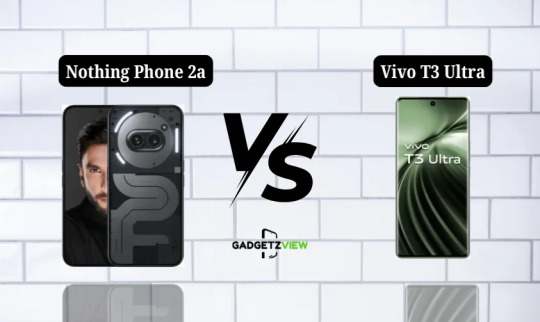#VivoT3Ultra
Explore tagged Tumblr posts
Text
Comparison of Nothing Phone 2a Plus and Vivo T3 Ultra

The smartphone market is buzzing with innovative devices, and two notable contenders are the Nothing Phone 2a Plus and the Vivo T3 Ultra. Each offers unique features designed to cater to different user needs, making it essential to analyze their specifications, designs, and performance to determine which might be the right choice for you.
Design and Build
The Nothing Phone 2a Plus stands out with its intriguing transparent back cover and minimalist aesthetic, focusing on an innovative design that enhances user experience. With dimensions of 76.3 x 161.7 x 8.55 mm and a weight of 190g, it is comfortable to hold and visually appealing. Available in Black and Grey, this phone is engineered for simplicity.
In contrast, the Vivo T3 Ultra showcases a modern, stylish design with a more conventional approach. Measuring 74.93 x 164.2 x 7.58 mm and weighing 192g, it offers a sleek profile in Lunar Gray and Frost Green. Both devices feature bezel-less designs and Corning Gorilla Glass 5 for durability.
Display
The Nothing Phone 2a Plus boasts a 6.7-inch Color AMOLED display with a resolution of 1084 x 2412 pixels, featuring a 120Hz refresh rate for smooth scrolling and interactions. Its peak brightness reaches 1300 nits, providing excellent visibility in various lighting conditions.
On the other hand, the Vivo T3 Ultra comes with a 6.78-inch Color AMOLED screen with a higher resolution of 1260 x 2800 pixels. It also features a 120Hz refresh rate and an impressive local peak brightness of 4500 nits, making it a standout for media consumption and gaming.
Performance and Software
In terms of performance, the Nothing Phone 2a Plus is powered by the MediaTek Dimensity 7350 Pro 5G chipset, with a CPU configuration of 3 GHz Octa-Core. This combination delivers optimized performance for multitasking and everyday use.
Conversely, the Vivo T3 Ultra is equipped with the MediaTek Dimensity 9200 Plus, featuring a more powerful 3.35 GHz Octa-Core CPU. This makes the Vivo T3 Ultra exceptionally well-suited for demanding applications, gaming, and high-performance tasks.
Both devices run on Android v14, with the Nothing Phone 2a Plus using Nothing OS 2.6 and the Vivo T3 Ultra featuring Funtouch OS 14. The choice of UI will cater to different user preferences, with the Nothing Phone focusing on a minimalist experience and the Vivo offering a more feature-rich interface.
Camera Capabilities
The Nothing Phone 2a Plus excels in its camera features, with a 50 MP rear camera (Sony IMX921) that includes optical image stabilization (OIS) and advanced features like Night Mode and AI Vivid Mode. Its front camera also impresses with a 50 MP wide-angle sensor, capable of recording 1080p and 4K videos.
In comparison, the Vivo T3 Ultra features a dual rear camera setup with a 50 MP wide-angle lens and an 8 MP ultra-wide sensor. It supports high-resolution photography and includes multiple shooting modes. The front camera also offers a 50 MP sensor, capable of recording videos in 4K at 60 fps.
Battery and Charging
When it comes to battery life, the Nothing Phone 2a Plus houses a 5000 mAh battery, supporting 50W fast charging and reverse charging capabilities, which is quite useful for on-the-go users.
The Vivo T3 Ultra features a slightly larger 5500 mAh battery with 80W flash charging support, allowing for quick top-ups, making it ideal for users who need extended battery life for heavy usage.
Conclusion
Ultimately, the decision between the Nothing Phone 2a Plus and the Vivo T3 Ultra boils down to individual preferences. The Nothing Phone impresses with its unique design, minimalist user experience, and strong camera capabilities, appealing to those who value aesthetics and simplicity. In contrast, the Vivo T3 Ultra shines in performance, battery life, and camera versatility, making it a great choice for power users and photography enthusiasts.
Both devices showcase the evolution of mobile technology, highlighting different strengths that cater to varying consumer needs in today's competitive smartphone market.
#NothingPhone2aPlus#VivoT3Ultra#SmartphoneComparison#TechReview#MobilePhones#PerformanceComparison#DisplayQuality
0 notes